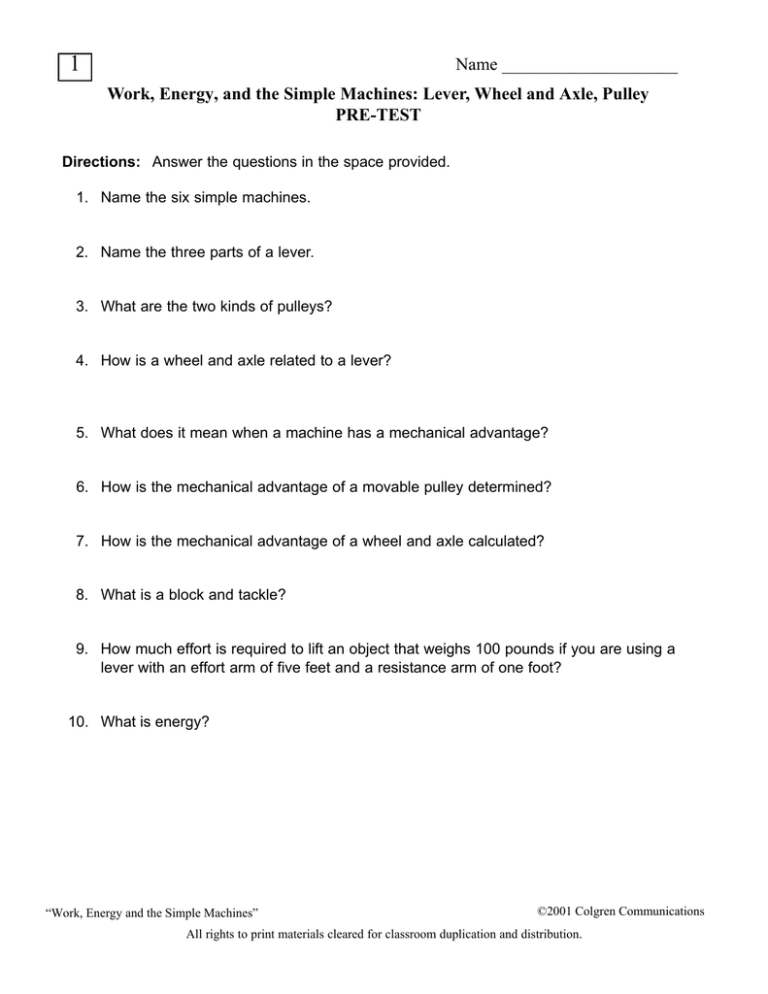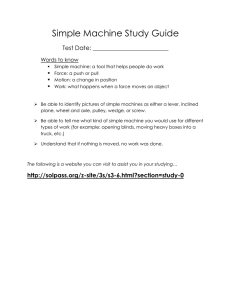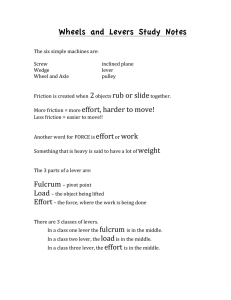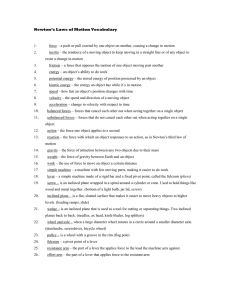Name Work, Energy, and the Simple Machines: Lever, Wheel and
advertisement

1 Name ____________________ Work, Energy, and the Simple Machines: Lever, Wheel and Axle, Pulley PRE-TEST Directions: Answer the questions in the space provided. 1. Name the six simple machines. 2. Name the three parts of a lever. 3. What are the two kinds of pulleys? 4. How is a wheel and axle related to a lever? 5. What does it mean when a machine has a mechanical advantage? 6. How is the mechanical advantage of a movable pulley determined? 7. How is the mechanical advantage of a wheel and axle calculated? 8. What is a block and tackle? 9. How much effort is required to lift an object that weighs 100 pounds if you are using a lever with an effort arm of five feet and a resistance arm of one foot? 10. What is energy? “Work, Energy and the Simple Machines” ©2001 Colgren Communications All rights to print materials cleared for classroom duplication and distribution. 2 Name ____________________ Work, Energy, and the Simple Machines: Lever, Wheel and Axle, Pulley VIDEO QUIZ At the end of the video presentation there will be a video quiz. You may use this worksheet to write your responses to the questions from the video quiz. 1. The turning point of a lever is called the ___________. a. resistance b. effort c. fulcrum d. arm 2. The load or object being moved on a lever is called the ___________. a. resistance b. effort c. fulcrum d. arm 3. The mechanical advantage of a wheel and axle is determined by _________. a. dividing the diameter of the wheel by the diameter of the axle b. dividing the axle radius by the wheel radius c. measuring the length of the effort arm d. dividing the resistance arm by the effort arm 4. How do we calculate the mechanical advantage of a movable pulley? a. Divide the length of the effort arm by the length of the resistance arm. b. Divide the wheel radius by the axle radius. c. Measure the length of the effort arm. d. Count the number of supporting strands of rope. 5. How do we calculate the mechanical advantage of a lever? a. Divide the length of the effort arm by the length of the resistance arm. b. Divide the wheel radius by the axle radius. c. Divide the length of the resistance arm by the length of the effort arm. d. Divide the weight of the load by the effort arm. 6. What is energy? __________________________________________________________ 7. How is a fixed pulley different from a movable pulley? ____________________________________ 8. What is a block and tackle? ___________________________________________________ 9. Name the six simple machines. _________________________________________________ 10. There are three kinds of levers. What makes them different from each other? “Work, Energy and the Simple Machines” ©2001 Colgren Communications All rights to print materials cleared for classroom duplication and distribution. 3 Name ____________________ Work, Energy, and the Simple Machines: Lever, Wheel and Axle, Pulley VOCABULARY Directions: Match the definitions in column B with the words in column A. Write the letter from column B next to the word in column A. COLUMN A COLUMN B 1. resistance _____ a. the ability to do work 2. effort _____ b. a pulley that makes work easier 3. fulcrum _____ c. the weight of the object being moved 4. energy _____ d. more than one pulley working together 5. fixed pulley _____ e. the force (push or pull) used to do work 6. movable pulley _____ f. a pulley that changes direction of effort but provides no mechanical advantage 7. mechanical advantage _____ g. the turning point of a lever 8. block and tackle _____ h. when a machine multiplies the effort being used “Work, Energy and the Simple Machines ©2001 Colgren Communications All rights to print materials cleared for classroom duplication and distribution. 4 Name ____________________ Work, Energy, and the Simple Machines: Lever, Wheel and Axle, Pulley LEVERS Levers were probably one of the very first machines. There are three parts to every lever. One part is the object or weight being moved. It is called the “resistance.” A push or pull is needed to move the resistance. This push or pull is called the “force.” The third part of the lever is called the “fulcrum.” It is the point on the lever where direction and movement changes. FORCE RESISTANCE FULCRUM DIRECTIONS: Label the parts of each lever shown. Each lever will have a fulcrum, a resistance, and a force. Hammer pulling nail from a board Pliers Hammer nailing Broom Moving a rock with board and log Nutcracker “Work, Energy and the Simple Machines” ©2001 Colgren Communications All rights to print materials cleared for classroom duplication and distribution. 5 Name ____________________ Work, Energy, and the Simple Machines: Lever, Wheel and Axle, Pulley LEVERS--THREE CLASSES There are three classes or kinds of levers. They are called FIRST-CLASS, SECOND-CLASS, or THIRDCLASS LEVERS. What makes one class of lever different from another is where the force, resistance, and fulcrum are located. Here are some examples: First-class lever In this case the fulcrum is located between the force and resistance. A seesaw is a good example of a first-class lever. Second-class lever A second-class lever is set-up so that the resistance is between the force and fulcrum. A wheelbarrow is a second-class lever. Third-class lever In the case of the third-class lever, the force is between the resistance and the fulcrum. A fishing pole is a good example. DIRECTIONS: Identify the levers below as first-class, second-class, or third-class levers. “Work, Energy and the Simple Machines” ©2001 Colgren Communications All rights to print materials cleared for classroom duplication and distribution. 6 Name ____________________ Work, Energy, and the Simple Machines: Lever, Wheel and Axle, Pulley TWO ARMS All levers have two arms, called the effort arm and the resistance arm. The effort arm is the distance from the fulcrum and the effort. The resistance arm is the distance from the fulcrum and the resistance. Effort Arm Resistance Arm E R This equation can be used to find unknowns: EFFORT FORCE X EFFORT ARM LENGTH = RESISTANCE FORCE X RESISTANCE ARM LENGTH Example: How much force is needed to move a rock that weighs 100 pounds using a lever with an effort arm length of four feet and a resistance arm length of one foot? 4 ft Solution: 100 lbs. 1 ft. 4 ft. x Fe = 100 lb. x 1 ft. 4ft. x Fe = 100 ft.-lbs. Fe = 100 ft.-lbs. / 4 ft. Fe = 25 lbs. Directions: Solve the following problems. 1. The effort arm is eight meters long and the resistance arm is 1.5 meters long on a lever. How much effort is needed to lift a 200 newton weight? 2. Two boys want to balance a seesaw perfectly. One boy weighs 120 pounds and is sitting four feet from the fulcrum. The other boy weighs 80 pounds. Where should the lighter boy sit to balance the seesaw? 3. A lever is being used to move a heavy stone from a garden. The stone weighs 250 newtons. The board used as a lever is six meters long. If two of the board’s meters will be used as the resistance arm how much force will be needed to move the rock? “Work, Energy and the Simple Machines” ©2001 Colgren Communications All rights to print materials cleared for classroom duplication and distribution. 7 Name ____________________ Work, Energy, and the Simple Machines: Lever, Wheel and Axle, Pulley MECHANICAL ADVANTAGE OF A LEVER The mechanical advantage (M.A.) of a lever is determined by dividing the length of the effort arm by the length of the resistance arm. Resistance Arm M.A. = Effort Arm/Resistance Arm Effort Arm M.A. = 6/1.5 M.A. = 4 1.5 m 6 meters Example: What is the mechanical advantage for a lever with an effort arm of five meters and a resistance arm of two meters? Solution: Effort arm = 5 m Resistance arm = 2 m M.A. = 5m/2m M.A. = 2.5 This means the effort is multiplied by 2.5 when using this lever. Directions: Try some mechanical advantage problems. Show work. 1. What is the M.A. of a lever with a resistance arm of 1.5 feet and an effort arm of three feet? 2. A lever has an effort arm of one meter. The resistance arm is .5 meters. What is the mechanical advantage? 3. What is the mechanical advantage of a lever with a resistance arm of 1.2 meters and an effort arm of three meters? “Work, Energy and the Simple Machines” ©2001 Colgren Communications All rights to print materials cleared for classroom duplication and distribution. 8 Name ____________________ Work, Energy, and the Simple Machines: Lever, Wheel and Axle, Pulley MECHANICAL ADVANTAGE OF A WHEEL AND AXLE The mechanical advantage (M.A.) for a wheel and axle is determined by dividing the diameter of the wheel by the diameter of the axle. Example: The diameter of a wheel is 25 cm and the diameter of the axle is 2 cm. What is the M.A. of the wheel and axle? Solution: Diameter of wheel = 25 cm Diameter of axle = 2 cm M.A. = 25 cm/2 cm M.A. = 12.5 Directions: Find the mechanical advantage of some wheel and axles from around your home. Here are some suggestions. Make measurements carefully. Show work. DOOR KNOB BICYCLE (Pedals and Rear Sprocket) PENCIL SHARPENER “Work, Energy and the Simple Machines” ©2001 Colgren Communications All rights to print materials cleared for classroom duplication and distribution. 9 Name ____________________ Work, Energy, and the Simple Machines: Lever, Wheel and Axle, Pulley KINDS OF PULLEYS DIRECTIONS: There are two kinds of pulleys. Do this experiment to find out about them. Answer the questions in the Observation section. Purpose: To demonstrate the uses and advantages of fixed and movable pulleys. Materials: 1. 2. 3. 4. 5. 6. two single pulleys twine three heavy books a spring scale desk ruler Part A: FIXED PULLEY Procedure: 1. Place the ruler over the edge of the desk and lay two of the books on it so the ruler will stay in place. 2. Take a pulley and attach it to the ruler with twine. 3. Tie twine around the other book and weigh the book with the spring scale. 4. Feed twine through the pulley wheel. Tie one end of the twine to the book. Tie the other end to the spring scale. 5. Pull the spring scale to lift the book. Record reading on scale. Part B: MOVABLE PULLEY Procedure: 1. 2. 3. 4. Repeat step 1 under Part A. Tie a long piece of twine to the end of the ruler. Feed the twine through the pulley wheel. Attach the book to the pulley and the spring scale to the end of the twine. 5. Lift the book by pulling on the twine. Record the spring scale reading. Observations: Part A 1. What was the weight of the book? _________ 2. What was the reading on the spring scale as you lifted the book with the pulley? ________ Part B 1. What was the reading on the spring scale as you lifted the book with this pulley? ________ “Work, Energy and the Simple Machines” ©2001 Colgren Communications All rights to print materials cleared for classroom duplication and distribution. 10 Name ____________________ Work, Energy, and the Simple Machines: Lever, Wheel and Axle, Pulley MECHANICAL ADVANTAGE OF PULLEYS The mechanical advantage (M.A.) that we get from a pulley is based on the number of supporting strands. FIXED PULLEY One supporting strand M.A. = 1 Effort needed to lift 10 gram weight is 10 grams MOVABLE PULLEY Two supporting strands M.A. = 2 Effort to lift 10 gram weight is 5 grams. Directions: Identify the M.A. of these pulleys and calculate the amount of effort required to lift the weight shown. 20 lb weight “Work, Energy and the Simple Machines” 75 newtons ©2001 Colgren Communications All rights to print materials cleared for classroom duplication and distribution. 11 Name ____________________ Work, Energy, and the Simple Machines: Lever, Wheel and Axle, Pulley POST-TEST DIRECTIONS: Answer these questions in the space provided. 1. Name the six simple machines. 2. Define these terms that are used in describing a lever: a.fulcrum __________________________________________________________ b.resistance __________________________________________________________ c. effort __________________________________________________________ d.effort arm __________________________________________________________ e.resistance arm _______________________________________________________ 3. There are three kinds or classes of levers. What makes one class of lever different from another? ______________________________________________________________ 4. Identify the resistance, effort, and fulcrum for these objects. 5. A 150 pound man is standing on a lever one foot from the fulcrum. How much effort must be used to lift the man if the effort is applied six feet from the fulcrum? 6. How is the mechanical advantage of a wheel of axle calculated? 7. How is the mechanical advantage of a pulley determined? 8. What is a block and tackle? 9. How is a fixed pulley different from a movable pulley? 10. What is energy? “Work, Energy and the Simple Machines” ©2001 Colgren Communications All rights to print materials cleared for classroom duplication and distribution.





